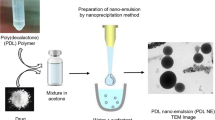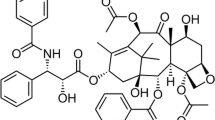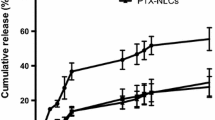Abstract
Purpose
In the present work, we developed water-in-oil (w/o) nanoemulsions for the intravesical administration of cisplatin.
Methods
The nanoemulsions were made up of soybean oil as the oil phase and Span 80, Tween 80, or Brij 98 as the emulsifier system. α-Terpineol and oleic acid were incorporated as permeation enhancers. The physicochemical characteristics of droplet size, zeta potential, and viscosity were determined. Nanoemulsions were administered intravesically for 1 ~ 4 h to rats in vivo. Animals were subsequently sacrificed, and the bladders were harvested to examine drug accumulation and histology.
Results
Ranges of the mean size and zeta potential were 30 ~ 90 nm and −3.4 to −9.3 mV, respectively. The addition of enhancers further reduced the size of the nanoemulsions. The viscosity of all systems exhibited Newtonian behavior. The cisplatin-loaded nanoemulsions were active against bladder cancer cells. The nanoemulsions with Brij 98 exhibited the complete inhibition of cell proliferation. The encapsulation of cisplatin and carboplatin, another derivative of cisplatin, in nanoemulsions resulted in slower and more-sustained release. The amount of drug which permeated into bladder tissues significantly increased when using carriers containing Brij 98, with the α-terpineol-containing formulation showing the best result. The nanoemulsion with α-terpineol prolonged the duration of higher drug accumulation to 3 ~ 4 h. At the later stage of administration (3 ~ 4 h), this system increased the bladder wall deposition of cisplatin and carboplatin by 2.4 ~ 3.3-fold compared to the control solution. Histological examination of the urothelium showed near-normal morphology in rats instilled with these nanoemulsions. α-Terpineol possibly caused slight desquamation of umbrella cells.
Conclusions
The nanoemulsions are feasible to load cisplatin for intravesical drug delivery.








Similar content being viewed by others
References
Nagabhushan TL, Maneval DC, Benedict WF, Wen SF, Ihnat PM, Engler H, et al. Enhancement of intravesical delivery with Syn3 potentiates interferon-alpha2b gene therapy for superficial bladder cancer. Cytokine Growth Factor Rev. 2007;18:389–394.
Avritscher EB, Cooksley CD, Grossman HB, Sabichi AL, Hamblin L, Dinney CP, et al. Clinical model of lifetime cost of treating bladder cancer and associated complications. Urology. 2006;68:549–553.
Witjes JA, Hendricksen K. Intravesical pharmacotherapy for non-muscle-invasive bladder cancer: a critical analysis of currently available drugs, treatment schedules, and long-term results. Eur Urol. 2008;53:45–52.
Skinner E. Will a new intravesical chemotherapy agent improve the treatment of non-muscle-invasive bladder cancer? Nat Clin Pract Urol. 2007;4:248–249.
Shen Z, Shen T, Wientjes MG, O’Donnell MA, Au JLS. Intravesical treatments of bladder cancer: review. Pharm. Res. 2008;25:1500–1510.
Lu Z, Yeh TK, Tsai M, Au JLS, Wientjes MG. Paclitaxel-loaded gelatin nanoparticles for intravesical bladder cancer therapy. Clin Cancer Res. 2004;10:7677–7684.
Tyagi P, Wu PC, Chancellor M, Yoshimura N, Huang L. Recent advances in intravesical drug/gene delivery. Mol. Pharmaceut. 2006;3:369–379.
Pectasides D, Pectasides M, Economopoulos T. Systemic chemotherapy in locally advanced and/or metastatic bladder cancer. Cancer Treat Rev. 2006;32:456–470.
Saxena S, Agrawal U, Agarwal A, Murthy NS, Mohanty K. Adjuvant intravesical therapy based on an in vitro cytotoxicity assay in the management of superficial transitional cell cancer of the urinary bladder. BJU Int. 2006;98:1012–1017.
Hadaschik BA, ter Borg MG, Jackson J, Sowery RD, So AI, Burt HM, et al. Paclitaxel and cisplatin as intravesical agents against non-muscle-invasive bladder cancer. BJU Int. 2008;101:1347–1355.
Wu H, Ramachandran C, Bielinska AU, Kingzett K, Sun R, Weiner ND, et al. Topical transfection using plasmid DNA in a water-in-oil nanoemulsion. Int J Pharm. 2001;221:23–34.
Wang JJ, Hung CF, Yeh CH, Fang JY. The release and analgesic activities of morphine and its ester prodrug, morphine propionate, formulated by water-in-oil nanoemulsions. J Drug Target. 2008;16:294–301.
Giannantoni A, Di Stasi SM, Chancellor MB, Costantini E, Porena M. New frontiers in intravesical therapies and drug delivery. Eur Urol. 2006;50:1183–1193.
Kirchmann H, Pettersson S. Human urine: chemical composition and fertilizer use efficiency. Nutr Cycl Agroecosyst. 1994;40:149–154.
Burgués Gasión JP, Jiménez Cruz JF. Improving efficacy of intravesical chemotherapy. Eur Urol. 2006;50:225–234.
Wang J, Maitani Y, Takayama K. Antitumor effects and pharmacokinetics of aclacinomycin A carried by injectable emulsions composed of vitamin E, cholesterol, and PEG-lipid. J Pharm Sci. 2002;91:1128–1134.
Hung CF, Fang CL, Liao MH, Fang JY. The effect of oil components on the physicochemical properties and drug delivery of emulsions: tocol emulsion versus lipid emulsion. Int J Pharm. 2007;335:193–202.
Hung CF, Chen JK, Liao MH, Lo HM, Fang JY. Development and evaluation of emulsion-liposome blends for resveratrol delivery. J Nanosci Nanotechnol. 2006;6:2950–2958.
Hurst RE, Zebrowski R. Identification of proteoglycans present at high density on bovine and human bladder luminal surface. J Urol. 1994;152:1641–1644.
Lawrence MJ, Rees GD. Microemulsion-based media as novel drug delivery systems. Adv Drug Deliv Rev. 2000;45:89–121.
Stefaniak M, Niestrój A, Klupsch J, Śliwiok J, Pyka A. Use of RP-TLC to determine the log P values of isomers of organic compounds. Chromatographia. 2005;62:87–89.
Buszello K, Harnisch S, Müller RH, Müller BW. The influence of alkali fatty acids on the properties and the stability of parenteral o/w emulsions modified with Solutol HS15®. Eur J Pharm Biopharm. 2000;49:143–149.
Solans C, Izquierdo P, Nolla J, Azemar N, Garcia-Celma MJ. Nano-emulsions. Curr Opin Colloid Interface Sci. 2005;10:102–110.
Ayannides CA, Ktistis G. A rheological study on microemulsion gels of isopropyl myristate, polysorbate 80, glycerol, and water. J Cosmet Sci. 1999;50:1–7.
Karasulu HY, Karabulut B, Göker E, Güneri T, Gabor F. Controlled release of methotrexate from w/o microemulsion and its in vitro antitumor activity. Drug Deliv. 2007;14:225–233.
Hatefi A, Amsden B. Camptothecin delivery methods. Pharm Res. 2002;19:1389–1399.
Fang JY, Hung CF, Hua SC, Hwang TL. Acoustically active perfluorocarbon nanoemulsions as drug delivery carriers for camptothecin: drug release and cytotoxicity against cancer cells. Ultrasonics. 2009;49:39–46.
Kim JH, Kim YS, Park K, Lee S, Nam HY, Min KH, et al. Antitumor efficacy of cisplatin-loaded glycol chitosan nanoparticles in tumor-bearing mice. J Control Release. 2008;127:41–49.
Yotsuyanagi T, Usami M, Noda Y, Nagata M. Computational consideration of cisplatin hydrolysis and acid dissociation in aqueous media: effect of total drug concentrations. Int J Pharm. 2002;246:95–104.
Hwang TL, Lee WR, Hua SC, Fang JY. Cisplatin encapsulated in phosphatidylethanolamine liposomes enhances the in vitro cytotoxicity and in vivo intratumor drug accumulation against melanomas. J Dermatol Sci. 2007;46:11–20.
Chung H, Kim TW, Kwon M, Kwon IC, Jeong SY. Oil components modulate physical characteristics and function of the natural oil emulsions as drug or gene delivery system. J Control Release. 2001;71:339–350.
Yoshioka T, Florence AT. Vesicle (noisome)-in-water-in-oil (v/w/o) emulsions: an in vitro study. Int J Pharm. 1994;108:117–123.
Paolino D, Ventura CA, Nisticò S, Puglisi G, Fresta M. Lecithin microemulsions for the topical administration of ketoprofen: percutaneous adsorption through human skin and in vivo human skin tolerability. Int J Pharm. 2002;244:21–31.
Bjerregaard S, Söderberg I, Vermehren C, Frokjaer S. Formulation and evaluation of release and swelling mechanism of a water-in-oil emulsion using factorial design. Int J Pharm. 1999;193:1–11.
Bjerregaard S, Söderberg I, Vermehren C, Frokjaer S. The effect of controlled osmotic stress on release and swelling properties of a water-in-oil emulsion. Int J Pharm. 1999;183:17–20.
Konishi M, Tabata Y, Kariya M, Hosseinkhani H, Suzuki A, Fukuhara K, et al. In vivo anti-tumor effect of dual release of cisplatin and adriamycin from biodegradable gelatin hydrogel. J Control Release. 2005;103:7–19.
Grabnar I, Bogataj M, Belič A, Logar V, Karba R, Mrhar A. Kinetic model of drug distribution in the urinary bladder wall following intravesical instillation. Int J Pharm. 2006;322:52–59.
Tadros T, Izquierdo P, Esquena J, Solans C. Formulation and stability of nano-emulsions. Adv Colloid Interface Sci. 2004;108–109:303–318.
Grabnar I, Bogataj M, Mrhar A. Influence of chitosan and polycarbophil on permeation of a model hydrophilic drug into the urinary bladder wall. Int J Pharm. 2003;256:167–173.
Kerec M, Boqataj M, Veranič P, Mrhar A. Permeability of pig urinary bladder wall: the effect of chitosan and the role of calcium. Eur J Pharm Sci. 2005;25:113–121.
Godwin DA, Michniak BB. Influence of drug lipophilicity on terpenes as transdermal penetration enhancers. Drug Dev Ind Pharm. 1999;25:905–915.
dos Anjos JL, Alonso A. Terpenes increase the partitioning and molecular dynamics of an amphipathic spin label in stratum corneum membranes. Int J Pharm. 2008;350:103–112.
Sylvester RJ, Oosterlinck W, Witjes JA. The schedule and duration of intravesical chemotherapy in patients with non-muscle-invasive bladder cancer: a systematic review of the published results of randomized clinical trials. Eur Urol. 2008;53:709–719.
Author information
Authors and Affiliations
Corresponding author
Rights and permissions
About this article
Cite this article
Hwang, TL., Fang, CL., Chen, CH. et al. Permeation Enhancer-Containing Water-In-Oil Nanoemulsions as Carriers for Intravesical Cisplatin Delivery. Pharm Res 26, 2314–2323 (2009). https://doi.org/10.1007/s11095-009-9947-6
Received:
Accepted:
Published:
Issue Date:
DOI: https://doi.org/10.1007/s11095-009-9947-6




